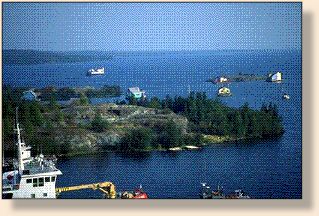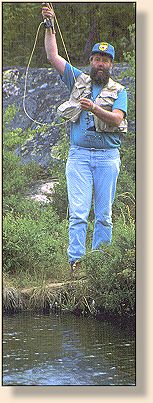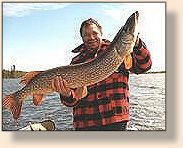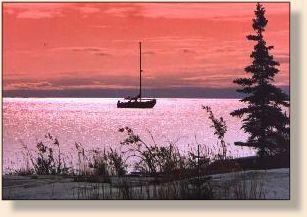Great Slave Lake
By Chris Hanks

Great Slave Lake is available, yet remote. Road access at
Hay River, Frank's Channel off the Mackenzie Highway, and at
Yellowknife, open only a small portion of the lake for casual
use. Most of the fifth largest lake in North America is still
only accessible by float plane or extended boat trip. A combination
of approaches make a myriad of angling opportunities possible. They
range from an afternoon of northern pike fishing with Morris Rabesca from
Naji Kwe Camp near the Frank's Channel Bridge, to a week split between
angling for pike near Enodah Lodge on the North Arm, and pursuing
lake trout and Artic grayling from Trophy Lodge on the East Arm.
Before gold strikes triggered the founding of the city of Yellowknife
in the late 1930's, the ancestors of the Yellowknives had exploited the
fish runs of Yellowknife Bay for generations. Their ancient fish camps
stretched from the mouth of the Yellowknife River to Gros Cap. Cached,
dried fish were an important hedge against the uncertainties of winter.
The early fur traders followed their example and established "Old"
Fort Providence southeast of the modern Yellowknives' community of Dettah.
Buit for alexander Mackenzie in 1796, the post served as a fishery for
the Northwest Company operations on Great Slave Lake. Today there is a
floating fish plant off Wool Bay only a few miles from the ruins of the
fort. The plant and the fish camps scattered near it underscore the
continued significance of the commercial fishery along the north shore
of Great Slave Lake.
 The islands of the north shore archipelago spread from Dettah to Gros Cap
at the entrance to the East Arm. They are glacially polished Precambrian
granite domes tufted with spruce and aspen. Their twisting shores
offer protected coves for boats and expanses of clear rock that make
casting painless. Below the surface, the undulating rock has created
wonderful fishy structures that occasionally remove the bottom end from
an outboard motor. Local Yellowknife guides can help you find lake trout,
northern pike, Artic grayling, and whitefish among the islands without
the pain of learning the waters.
The islands of the north shore archipelago spread from Dettah to Gros Cap
at the entrance to the East Arm. They are glacially polished Precambrian
granite domes tufted with spruce and aspen. Their twisting shores
offer protected coves for boats and expanses of clear rock that make
casting painless. Below the surface, the undulating rock has created
wonderful fishy structures that occasionally remove the bottom end from
an outboard motor. Local Yellowknife guides can help you find lake trout,
northern pike, Artic grayling, and whitefish among the islands without
the pain of learning the waters.
When I met Steve and Louise Matthews at Yellowknife's Wildcat Cafe
for breakfast, Louise and I exchanged our customary joke about pack
horses. Years ago when I worked for the Price of Wales Northern
Heritage Centre, Louise had been the department finance officer who
had reviewed an invoice for a string of pack horses I had blithely
attached to a travel advance. I subsequently disappeared back into
the field on another project while the fur flew in Yellowknife. By
the time I returned, someone had decided that horses were the same as
renting a boat and I was almost forgiven. Thank heavens I never asked
permission, forgiveness was hard enough to come by.
When Steve had a chance to break in on our revelry, he quietly
suggested an afternoon fishing trip to Wool Bay. Household tasks
aside, it was Father's Day and he wanted to try out his new fly rod.
Although Steve and I were set on Artic grayling, Louise suggested
that it would be nice if we brought home a big northern pike for
dinner. On the way down Yellowknife Bay, Steve described his
favourite method for filleting pike to remove all of the bones.
He then uses the groove left in the flesh for cutting the lower
row of bones out to insert stuffing when he bakes the pike in foil.
It was obvious Louise planned for Steve to prepare the barbecue.

In deference to the threat of small craft warnings, Steve and I
stopped at an island only a few miles past Dettah. If we had
gone on to the more protected waters near Wool Bay, it would have
been easy to miss a change in the wind. There would be other
gentler times for pushing on to more distant waters.
The rock pools, in the lap of the waves, contained a mixture of
black stonefly nymphs (size 2X to size 8), a few tan caddis
(size 18), and the prerequisite number of midges (size 18 and
size 20). Stoneflies crawling up the rocks to emerge were the
hatch of the day. I had encountered the same fly, four weeks
earlier, south of Great Slave lake along the Kakisa River.
Spring on the north shore is retarded by the slow retreat of the
ice from the centre of the lake. Swarms of dragonflies were
darting through the air eating mosquitoes on the wind. Wind
gusts downed the "mosquito hawks" that turned too tightly near
the water,making them the afternoon's only dry fly activity.
When Steve watched a grayling come up and nose the same
struggling dragonfly twice before it turned away, it was
obvious that the fish were not really interested. If the
grayling had been feeding so heavily that they were too full
for struggling dragonflies, they had to be feasting on
stonefly nymphs.
 Rigging for the bottom, Steve chose a full sinking line while
I slipped on a sinking tip. We both used 6 weight rods to turn
the weighted nymphs. Imitating the slender black stonefly
required a sparse pattern. I chose a clipped Woolly Worm with
a split goose quill tail that gave the correct general impression,
while Steve selected a very thin Black Muddler with a sparse wing
that imitated the profile. Sinking the flies we worked them
slowly up the rocky shore along the path of the naturals. The
exercise was rough on flies and attracted no grayling. We
fished the mid-water with attractor patterns, but nothing happened.
The bluster had pushed a smorgasbord of drowned insects from the
windward shore, but no grayling were feeding in the eddies at the
ends of the island where the flotsam and jetsam rafted out of the
wind. I changed to a more exacting imitation. When that failed,
we tried one of Steve's favorite tricks and fished the windward
side where the grayling collect to feed on food stirred up by the
waves. Switching to a floating line, I worked a dry fly over
shallow shoals near shore, while Steve retrieved his spinning rod
to try for pike. In the end, we did not even get a pike for
Louise.
Rigging for the bottom, Steve chose a full sinking line while
I slipped on a sinking tip. We both used 6 weight rods to turn
the weighted nymphs. Imitating the slender black stonefly
required a sparse pattern. I chose a clipped Woolly Worm with
a split goose quill tail that gave the correct general impression,
while Steve selected a very thin Black Muddler with a sparse wing
that imitated the profile. Sinking the flies we worked them
slowly up the rocky shore along the path of the naturals. The
exercise was rough on flies and attracted no grayling. We
fished the mid-water with attractor patterns, but nothing happened.
The bluster had pushed a smorgasbord of drowned insects from the
windward shore, but no grayling were feeding in the eddies at the
ends of the island where the flotsam and jetsam rafted out of the
wind. I changed to a more exacting imitation. When that failed,
we tried one of Steve's favorite tricks and fished the windward
side where the grayling collect to feed on food stirred up by the
waves. Switching to a floating line, I worked a dry fly over
shallow shoals near shore, while Steve retrieved his spinning rod
to try for pike. In the end, we did not even get a pike for
Louise.

Later at the dock in Yellowknife, we heard a few "you should have been there
yesterday" stories. Bill Cody complained about fog along the ice edge
out near the West Mirage Island. Not even ardent spin fishermen really
wanted to talk about Artic grayling. Undaunted, on the way up the path
to the house, Steve and I mused about the terrific dry fly action we
would find in a few days when the stoneflies emerged from their nymphal
shucks. Artic grayling can be as picky as snotty South Platte River
browns that turn and fin away from a fly one size too large. Fortunately
this Father's Day experience is not the rule, fishing south of Dettah
is generally very good. ~ Chris Hanks
Continued next time.
From Fly Fishing in the Northwest Territories of Canada, Published
by Frank Amato Publications.We appreciate use permission. Photos, other than of the author,
courtesy Yellowknife Tourism.
Our Man In Canada Archives
|

